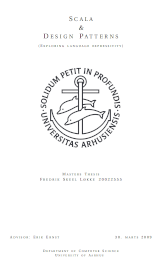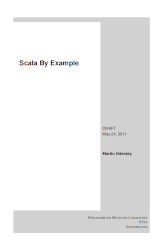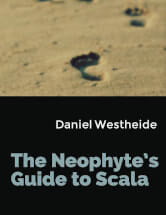Last Updated on May 22, 2022
9. Scala & Design Patterns: Exploring Language Expressivity by Frederik Skeel Løkke
 This thesis explores a well known catalog of design patterns in the context of the programming language Scala. Design patterns do in general not exist as reusable components.
This thesis explores a well known catalog of design patterns in the context of the programming language Scala. Design patterns do in general not exist as reusable components.
Scala features novel abstraction mechanisms with a strong focus on the writing of components and is thus interesting to explore in the context of design patterns. General implementation problems concerning design patterns are identified. The analysis of the catalog shows that Scala can deal with some of these problems. Components for three patterns are provided, but in general Scala lacks the needed abstraction mechanisms. The principles behind design patterns, has long been regarded as sound engineering advice. The second principle, “Favor object composition over class inheritance”, is shown to be weakened in Scala. Further, a language feature proposal is presented, that if present in Scala in its full generality would result in the need for reevaluation of the principle.
10. Scala By Example by Martin Odersky
 This document introduces Scala in an informal way, through a sequence of examples. Chapters 2 and 3 highlight some of the features that make Scala interesting.
This document introduces Scala in an informal way, through a sequence of examples. Chapters 2 and 3 highlight some of the features that make Scala interesting.
The following chapters introduce the language constructs of Scala in a more thorough way, starting with simple expressions and functions, and working up through objects and classes, lists and streams, mutable state, pattern matching to more complete examples that show interesting programming techniques. The present informal exposition is meant to be complemented by the Scala Language Reference Manual which specifies Scala in a more detailed and precise way.
11. The Neophyte’s Guide to Scala by Daniel Westheide
 The Neophyte’s Guide to Scala is a book for intermediate Scala developers.
The Neophyte’s Guide to Scala is a book for intermediate Scala developers.
In this book, you will learn the details of how to employ pattern matching and extractors, working with the omnipresent Option and similar types in an idiomatic way, and leveraging higher-order functions and currying to keep your code DRY.
Furthermore, you will gain insight into advanced Scala features like type classes and path-dependent types and about Scala’s approach at concurrent programming: Learn about the power of Scala’s futures and the actor model, as implemented in the popular Akka toolkit.
Pages in this article:
Page 1 – Programming in Scala and more books
Page 2 – The Type Astronaut’s Guide to Shapeless Book and more books
Page 3 – Scala & Design Patterns: Exploring Language Expressivity and more books
All books in this series:
| Free Programming Books | |
|---|---|
| Ada | ALGOL-like programming language, extended from Pascal and other languages |
| Agda | Dependently typed functional language based on intuitionistic Type Theory |
| Arduino | Inexpensive, flexible, open source microcontroller platform |
| Assembly | As close to writing machine code without writing in pure hexadecimal |
| Awk | Versatile language designed for pattern scanning and processing language |
| Bash | Shell and command language; popular both as a shell and a scripting language |
| BASIC | Beginner’s All-purpose Symbolic Instruction Code |
| C | General-purpose, procedural, portable, high-level language |
| C++ | General-purpose, portable, free-form, multi-paradigm language |
| C# | Combines the power and flexibility of C++ with the simplicity of Visual Basic |
| Clojure | Dialect of the Lisp programming language |
| ClojureScript | Compiler for Clojure that targets JavaScript |
| COBOL | Common Business-Oriented Language |
| CoffeeScript | Transcompiles into JavaScript inspired by Ruby, Python and Haskell |
| Coq | Dependently typed language similar to Agda, Idris, F* and others |
| Crystal | General-purpose, concurrent, multi-paradigm, object-oriented language |
| CSS | CSS (Cascading Style Sheets) specifies a web page’s appearance |
| D | General-purpose systems programming language with a C-like syntax |
| Dart | Client-optimized language for fast apps on multiple platforms |
| Dylan | Multi-paradigm language supporting functional and object-oriented coding |
| ECMAScript | Best known as the language embedded in web browsers |
| Eiffel | Object-oriented language designed by Bertrand Meyer |
| Elixir | Relatively new functional language running on the Erlang virtual machine |
| Erlang | General-purpose, concurrent, declarative, functional language |
| F# | Uses functional, imperative, and object-oriented programming methods |
| Factor | Dynamic stack-based programming language |
| Forth | Imperative stack-based programming language |
| Fortran | The first high-level language, using the first compiler |
| Go | Compiled, statically typed programming language |
| Groovy | Powerful, optionally typed and dynamic language |
| Haskell | Standardized, general-purpose, polymorphically, statically typed language |
| HTML | HyperText Markup Language |
| Icon | Wide variety of features for processing and presenting symbolic data |
| J | Array programming language based primarily on APL |
| Java | General-purpose, concurrent, class-based, object-oriented, high-level language |
| JavaScript | Interpreted, prototype-based, scripting language |
| Julia | High-level, high-performance language for technical computing |
| Kotlin | More modern version of Java |
| LabVIEW | Designed to enable domain experts to build power systems quickly |
| LaTeX | Professional document preparation system and document markup language |
| Lisp | Unique features - excellent to study programming constructs |
| Logo | Dialect of Lisp that features interactivity, modularity, extensibility |
| Lua | Designed as an embeddable scripting language |
| Markdown | Plain text formatting syntax designed to be easy-to-read and easy-to-write |
| Objective-C | Object-oriented language that adds Smalltalk-style messaging to C |
| OCaml | The main implementation of the Caml language |
| Pascal | Imperative and procedural language designed in the late 1960s |
| Perl | High-level, general-purpose, interpreted, scripting, dynamic language |
| PHP | PHP has been at the helm of the web for many years |
| PostScript | Interpreted, stack-based and Turing complete language |
| Prolog | A general purpose, declarative, logic programming language |
| PureScript | Small strongly, statically typed language compiling to JavaScript |
| Python | General-purpose, structured, powerful language |
| QML | Hierarchical declarative language for user interface layout - JSON-like syntax |
| R | De facto standard among statisticians and data analysts |
| Racket | General-purpose, object-oriented, multi-paradigm, functional language |
| Raku | Member of the Perl family of programming languages |
| Ruby | General purpose, scripting, structured, flexible, fully object-oriented language |
| Rust | Ideal for systems, embedded, and other performance critical code |
| Scala | Modern, object-functional, multi-paradigm, Java-based language |
| Scheme | A general-purpose, functional language descended from Lisp and Algol |
| Scratch | Visual programming language designed for 8-16 year-old children |
| SQL | Access and manipulate data held in a relational database management system |
| Standard ML | General-purpose functional language characterized as "Lisp with types" |
| Swift | Powerful and intuitive general-purpose programming language |
| Tcl | Dynamic language based on concepts of Lisp, C, and Unix shells |
| TeX | Markup and programming language - create professional quality typeset text |
| TypeScript | Strict syntactical superset of JavaScript adding optional static typing |
| Vala | Object-oriented language, syntactically similar to C# |
| VHDL | Hardware description language used in electronic design automation |
| VimL | Powerful scripting language of the Vim editor |
| XML | Rules for defining semantic tags describing structure ad meaning |
